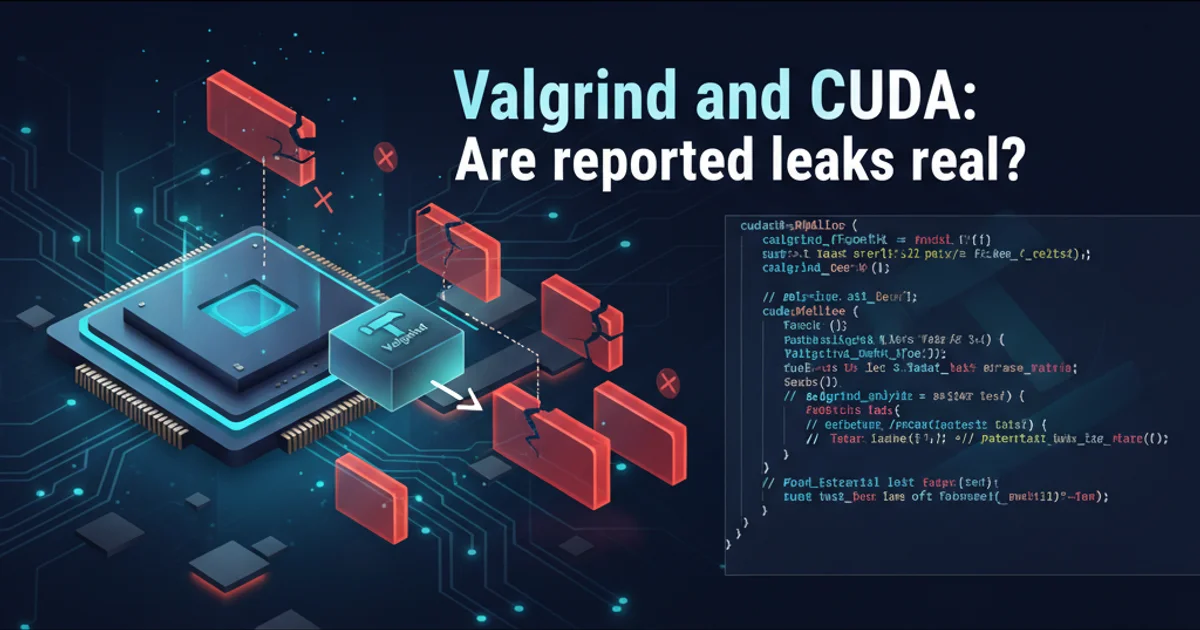Valgrind and CUDA: Are reported leaks real?
Categories:
Valgrind and CUDA: Understanding Reported Memory Leaks

Explore the complexities of using Valgrind with CUDA applications. Learn why some reported memory leaks might not be real issues and how to accurately diagnose memory problems in your GPU-accelerated code.
Valgrind is an invaluable tool for detecting memory errors and leaks in C/C++ applications. However, when applied to CUDA programs, its output can sometimes be misleading. Developers often encounter reports of memory leaks that, upon closer inspection, turn out to be false positives or expected behavior related to how CUDA manages device memory. This article delves into the nuances of using Valgrind with CUDA, helping you distinguish between genuine memory leaks and benign reports.
Why Valgrind Reports Can Be Misleading with CUDA
The primary reason for Valgrind's seemingly erroneous reports in CUDA applications stems from its design. Valgrind operates by instrumenting CPU-side code. It has no inherent understanding of GPU memory management or the CUDA runtime API's internal workings. When CUDA allocates device memory (e.g., via cudaMalloc), this memory is managed by the GPU driver and runtime, not directly by the host CPU's memory allocator that Valgrind monitors. Valgrind sees the host-side calls to cudaMalloc but doesn't track the corresponding cudaFree calls because they operate on a different memory domain (the GPU).
flowchart TD
A[CUDA Application (Host)] --> B{cudaMalloc() Call}
B --> C[CUDA Runtime/Driver]
C --> D[GPU Device Memory Allocation]
D -- Valgrind does NOT track --> E[Memory on GPU]
E -- Valgrind sees no corresponding free --> F[Valgrind Reports 'Leak']
F --> G{Is it a real leak?}
G -- No, it's GPU memory --> H[False Positive]
G -- Yes, host memory --> I[Real Leak (Host)]How Valgrind's CPU-centric view can lead to false positives with CUDA device memory.
Specifically, Valgrind might report 'still reachable' or 'definitely lost' memory for allocations made by the CUDA runtime itself, or for device memory that is correctly managed by CUDA but not explicitly freed by the host before the program exits. This is particularly common for internal buffers used by the CUDA driver or for device memory that is intentionally kept allocated until the application terminates, relying on the OS to reclaim resources.
Identifying Real Leaks vs. False Positives
To effectively use Valgrind with CUDA, you need a strategy to differentiate between actual memory leaks and benign reports. The key is to focus on host-side memory allocations that are not related to CUDA device memory management.
1. Filter Valgrind Output: Valgrind allows suppression files to ignore specific reports. You can create a suppression file to silence reports originating from CUDA runtime libraries. However, this should be done cautiously, as it might hide genuine host-side leaks if not configured precisely.
2. Isolate Host Code: Run Valgrind on the host-only parts of your application first, before integrating CUDA calls. This helps establish a baseline for host memory behavior.
3. Focus on cudaMallocHost and cudaHostAlloc: If you are using pinned host memory, these allocations are host-side and should be paired with cudaFreeHost. Valgrind can detect leaks in these allocations.
4. Check for cudaFree: Ensure every cudaMalloc has a corresponding cudaFree call for device memory that you explicitly manage. While Valgrind won't track the device memory itself, a missing cudaFree indicates a logical leak in your application's resource management, even if Valgrind doesn't directly report it as a 'memory leak' in its traditional sense.
#include <cuda_runtime.h>
#include <stdio.h>
void host_function_with_leak() {
int *host_ptr = (int*)malloc(10 * sizeof(int));
// Missing free(host_ptr); - Valgrind will detect this
}
void cuda_device_allocation() {
int *dev_ptr;
cudaMalloc((void**)&dev_ptr, 10 * sizeof(int));
// Missing cudaFree(dev_ptr); - Valgrind won't report as 'leak' directly
// but it's a resource leak in your CUDA code.
}
int main() {
host_function_with_leak();
cuda_device_allocation();
// Example of a host-side allocation that Valgrind will track
int *another_host_ptr = (int*)malloc(5 * sizeof(int));
free(another_host_ptr);
printf("Program finished.\n");
return 0;
}
Example demonstrating a host-side leak (detectable by Valgrind) and a device-side resource leak (not directly reported by Valgrind).
malloc/free or new/delete calls. Reports originating deep within CUDA driver libraries are often benign.Tools for CUDA Memory Debugging
While Valgrind has limitations with CUDA device memory, other tools are specifically designed for GPU memory debugging:
CUDA-MEMCHECK: This is NVIDIA's own memory error checking tool, part of the CUDA Toolkit. It can detect out-of-bounds accesses, uninitialized memory reads, and memory leaks on the device. It's the primary tool for debugging device memory issues.
NVIDIA Nsight Compute/Systems: These profiling tools can provide detailed insights into memory usage patterns, allocations, and deallocations on the GPU, helping you identify inefficiencies or potential resource leaks.
Combining Valgrind for host-side memory issues with CUDA-MEMCHECK for device-side issues provides a comprehensive memory debugging strategy for CUDA applications.
1. Run Valgrind for Host-Side Analysis
Execute your CUDA application with Valgrind, focusing on host-side memory allocations. Use a suppression file if necessary to filter out known CUDA runtime noise. Example command: valgrind --leak-check=full --show-leak-kinds=all --suppressions=cuda.supp ./my_cuda_app
2. Run CUDA-MEMCHECK for Device-Side Analysis
After addressing host-side issues, run your application with CUDA-MEMCHECK to detect device memory errors and leaks. Example command: cuda-memcheck ./my_cuda_app
3. Analyze and Correlate Reports
Carefully review the output from both tools. Distinguish between Valgrind's host-side reports and CUDA-MEMCHECK's device-side reports. A 'leak' reported by Valgrind originating from cudaMalloc is likely a false positive, but a missing cudaFree in your code (which CUDA-MEMCHECK might highlight as an unreleased resource) is a real issue.